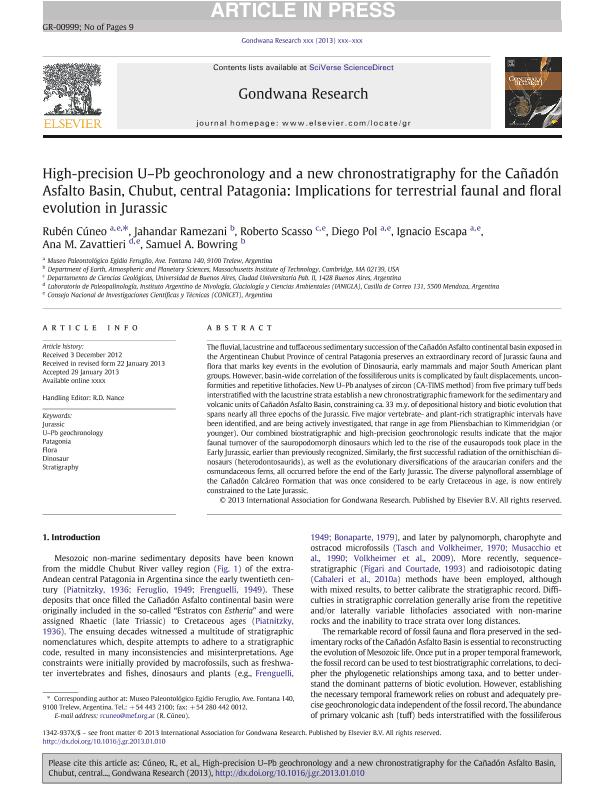Artículo
High-precision U-Pb geochronology and a new chronostratigraphy for the Cañadón Asfalto Basin, Chubut, central Patagonia: Implications for terrestrial faunal and floral evolution in Jurassic
Cúneo, Néstor Rubén ; Ramezani, Jahandar; Scasso, Roberto Adrian
; Ramezani, Jahandar; Scasso, Roberto Adrian ; Pol, Diego
; Pol, Diego ; Escapa, Ignacio Hernán
; Escapa, Ignacio Hernán ; Zavattieri, Ana Maria
; Zavattieri, Ana Maria ; Bowring, Samuel
; Bowring, Samuel
 ; Ramezani, Jahandar; Scasso, Roberto Adrian
; Ramezani, Jahandar; Scasso, Roberto Adrian ; Pol, Diego
; Pol, Diego ; Escapa, Ignacio Hernán
; Escapa, Ignacio Hernán ; Zavattieri, Ana Maria
; Zavattieri, Ana Maria ; Bowring, Samuel
; Bowring, Samuel
Fecha de publicación:
11/2013
Editorial:
Elsevier Science
Revista:
Gondwana Research
ISSN:
1342-937X
Idioma:
Inglés
Tipo de recurso:
Artículo publicado
Clasificación temática:
Resumen
The fluvial, lacustrine and tuffaceous sedimentary succession of the Cañadón Asfalto continental basin exposed in the Argentinean Chubut Province of central Patagonia preserves an extraordinary record of Jurassic fauna and flora that marks key events in the evolution of Dinosauria, early mammals and major South American plant groups. However, basin-wide correlation of the fossiliferous units is complicated by fault displacements, unconformities and repetitive lithofacies. New U-Pb analyses of zircon (CA-TIMS method) from five primary tuff beds interstratified with the lacustrine strata establish a new chronostratigraphic framework for the sedimentary and volcanic units of Cañadón Asfalto Basin, constraining ca. 33. m.y. of depositional history and biotic evolution that spans nearly all three epochs of the Jurassic. Five major vertebrate- and plant-rich stratigraphic intervals have been identified, and are being actively investigated, that range in age from Pliensbachian to Kimmeridgian (or younger). Our combined biostratigraphic and high-precision geochronologic results indicate that the major faunal turnover of the sauropodomorph dinosaurs which led to the rise of the eusauropods took place in the Early Jurassic, earlier than previously recognized. Similarly, the first successful radiation of the ornithischian dinosaurs (heterodontosaurids), as well as the evolutionary diversifications of the araucarian conifers and the osmundaceous ferns, all occurred before the end of the Early Jurassic. The diverse palynofloral assemblage of the Cañadón Calcáreo Formation that was once considered to be early Cretaceous in age, is now entirely constrained to the Late Jurassic. © 2012 International Association for Gondwana Research.
Palabras clave:
Dinosaur
,
Flora
,
Jurassic
,
Patagonia
,
Stratigraphy
,
U-Pb Geochronology
Archivos asociados
Licencia
Identificadores
Colecciones
Articulos(IANIGLA)
Articulos de INST. ARG. DE NIVOLOGIA, GLACIOLOGIA Y CS. AMBIENT
Articulos de INST. ARG. DE NIVOLOGIA, GLACIOLOGIA Y CS. AMBIENT
Articulos(IGEBA)
Articulos de INSTITUTO DE GEOCIENCIAS BASICAS, APLICADAS Y AMBIENTALES DE BS. AS
Articulos de INSTITUTO DE GEOCIENCIAS BASICAS, APLICADAS Y AMBIENTALES DE BS. AS
Articulos(SEDE CENTRAL)
Articulos de SEDE CENTRAL
Articulos de SEDE CENTRAL
Citación
Cúneo, Néstor Rubén; Ramezani, Jahandar; Scasso, Roberto Adrian; Pol, Diego; Escapa, Ignacio Hernán; et al.; High-precision U-Pb geochronology and a new chronostratigraphy for the Cañadón Asfalto Basin, Chubut, central Patagonia: Implications for terrestrial faunal and floral evolution in Jurassic; Elsevier Science; Gondwana Research; 24; 3-4; 11-2013; 1267-1275
Compartir
Altmétricas



